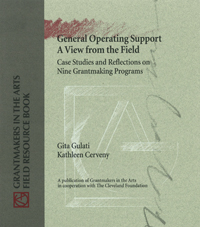Public Agency
Public Agency
This article takes a look at strategic or effective philanthropyfunding which actively seeks to efficiently achieve a donor's goalsand assesses some ways in which strategic philanthropy is structured.
Free online from the Stanford Social Innovation Review
Download:
![]() Smart Money (3.35Mb)
Smart Money (3.35Mb)
This brief presents research findings as well as policy recommendations arising from a study of the No Child Left Behind Act and its implications for immigrant children and English language learners (ELLs). Analyses are based on nationally-representative data from the Schools and Staffing Survey and detailed case studies of selected elementary schools and school districts serving high concentrations of ELL students. Results reveal an extraordinary degree of concentration of ELL students in a few schools that tend to be large, urban and serve a predominantly minority student population.
Read More...
At a time when public support of the arts faces a range of challenges, state arts agencies could use a framework to help them better serve the arts community and engage more people in the arts -- thereby elevating these agencies' public value.
Read More...Council on Foundations Annual Conference, May 1, 2001
Craig McGarvey, The James Irvine Foundation
From a position of received privilege, how should one behave so that it might be put to productive use as people are learning to get better at their work? This is a central question facing philanthropy, and it figured centrally in preparations for today. How to say something appropriate and helpful under such extraordinary circumstances?
There was the problem that no single foundation's body of work could possibly measure up to being singled out.
Read More...Native America at the new Millennium is a Ford Foundation-funded collaboration by the Harvard Project, Native Nations Institute, and First Nations Development Institute that serves as a primer on contemporary American Indian affairs. NANM addresses topics as wide-ranging as tribal government, non-profit organizations, political activism, economic development, housing, welfare, health, arts, and media.
Read More...This brief article offers a concise and practical look at the important difference between "outcomes" and "impact" in measuring the effectiveness of grants and programs, and provides information on designing evaluation methods and what measures to best apply.
Posted courtesy of the Stanford Social Innovation Review.
Download:
![]() On the Frontlines (312Kb)
On the Frontlines (312Kb)
This article demonstrates how the income tax break for charitable contributions effectively creates an inequitable federal subsidy of some charitable organizations over others, and proposes policy changes that would address this situation.
Download:
![]() Failure of Philanthropy (362Kb)
Failure of Philanthropy (362Kb)

This book features profiles of 18 family foundations and giving groups that have developed unique or noteworthy programs of arts giving, reflecting the values and character of the donors in a variety of ways. Interviews with principals and trustees from each foundation provide further insights to how these programs were developed and realized.
90 pages, perfect bound
ISBN 0-9705157-4-X

This Field Resource Book profiles nine foundations that provide general operating support to arts organizations. The featured foundations reflect geographic and institutional diversity, as well as myriad grantmaking approaches. The chapters are the result of research and interviews with senior staff at each of the nine foundations.
Each chapter includes six sections:

